Rizal Park
(also known as: Luneta or Luneta Park)
Manila
Share this page:
Rizal Park, also known as the Luneta (or "little moon"), is an oasis of greenery in the middle of the hustle and bustle of Manila. Here you will see people strolling, families having picnics, courting couples, people playing chess, and in the early morning, joggers and tai-chi practitioners. There are free concerts on Sundays.
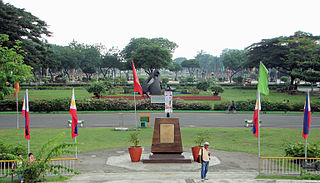
General view of Rizal Park (Photo: P199)
At one end of the park (near the children's playground), you can catch great views of magnificent sunsets over Manila Bay.
Rizal Park is 58 hectares in size and is located at the northern end of Roxas Boulevard. Towards the western end of this park is the Rizal Monument, built in remembrance of the national hero of the Philippines, José Rizal, who was executed near here by the Spanish colonial authorities in 1896.
SO MANY ATTRACTIONS
There are many things to see in the Park:
Western Section
-- Quirino Grandstand
-- Parade Ground
-- Carabao Statue
-- Tamaraw Stature
-- Kilometer Zero
-- Memorial Clock
-- Manila Ocean Park
Central Section
-- Rizal Monument
-- Martyrdom of Rizal Diorama
-- Noli Me Tangere Garden (with the Heidelberg Fountain)
-- Bust of Ferdinand Blumentritt
-- Philippine Flagpole
-- Gomburza Marker
-- La Madre Filipina (statue)
-- Binhi ng Kalayaan Garden
-- Chinese Garden
-- Japanese Garden
-- Open Air Auditorium
-- Chess Plaza
-- Central Lagoon
-- Gallery of Heroes
-- Manila Planetarium
-- Orchidarium and Butterfly Pavilion
-- Open Air Auditorium
-- National Library of the Philippines
Eastern Section
-- Relief Map of the Philippine Islands
-- Outdoor Roller Skating Rink
-- Children’s Playground
-- Botanical Garden, Rizal Park
-- Museum of the Filipino People
-- National Museum of the Philippines
Miscellaneous
-- Andres Bonifacio Monument
-- Flower Clock
-- Luzviminda Boardwalk
PRE-SPANISH ERA
Hundreds of years ago that area that is now Rizal Park was occupied by Bagumbayan (Tagalog, "New Town"), a large barangay (Tagalog, "precinct") ruled by the Islamic ruler Tariq Salalila (also known as Rajah Sulayman). The area was mostly marshy ground.
SPANISH ERA
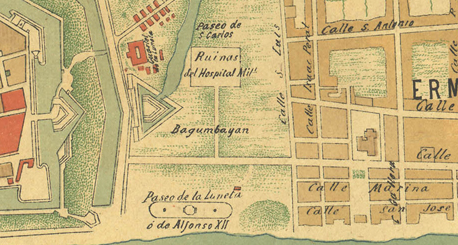
View of Bagumbayan or Luneta (now Rizal Park) as it was in Spanish era Manila in 1898.
In the center are the Paseo de la Luneta o de Alfonso XII (Plaza of Luneta or of Alfonso XII). Also marked are the Luneta Barracks and the ruins of the military hospital
To the left of Bagumban we can see the walls of Intramuros and to the right the suburb of Ermita.
When the Spanish arrived in Manila in 1571, they built a walled city, Intramuros, just the the north of Bagumbayan.
In 1574 a Chinese warlord named Limahong besieged Intramuros. The Spanish then took over Bagumbayan as that area provided an excellent defence for their adjacent walled city. The Spanish proceed to build a town called Nuevo Barrio (Spanish, "New Town") in Bagumbayan. It had its own church.
During the brief British occupation of Manila (1762-64) during the Seven Years’ War, the British razed Nuevo Barrio to the ground so they could get a better line of fire towards Intramuros. The empty fields left became known as Bagumbayan Field.
After the British left, the Spaniards returned and constructed a barracks (Cuarto de la Luneta, or Luneta Barracks), a military hospital and some crescent-shaped outworks shielding the Puerta Real gate in the adjacent Intramuros moat just to the north. (The crescent-shape was called Luneta, literally "little moon", in the Spanish language. The word Luneta was to become a popular name for Bagumbayan Field, whose name was later officially to become Rizal Park.)
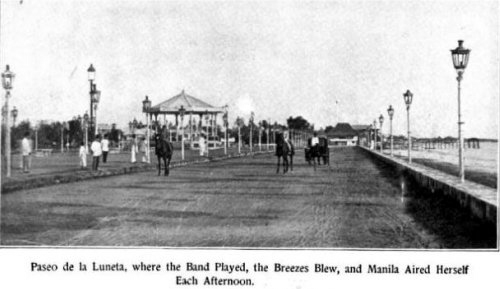
View of the Paseo de la Luneta (Plaza of Luneta) in 1894. We can see a bandstand and to the right Manila Bay.
In 1820 the Spanish built the Paseo de la Luneta (Plaza of the Luneta) at the western end of Bagumbayan Field. This plaza included lawns, paths, a promenade, a bandstand, and two fountains. It became a popular spot for Manila’s elite to mingle and socialize after vespers every evening. A military band would play most evenings. Carriages would make their way along La Calzada (Spanish, "The Carriageway") that ringed the plaza.
Between 1823 and 1897 the area had a more sinister use. In that period the Spaniards used Bagumbayan Field as an execution ground and 158 patriots were executed there. These included Fathers Gomez, Burgos and Zamora (known collectively as the Gomburza) in 1872, Jose Rizal on 30 December 1896, and many others (mostly executed in groups during the Philippine Revolution (1896-98) by Spanish army firing squads.
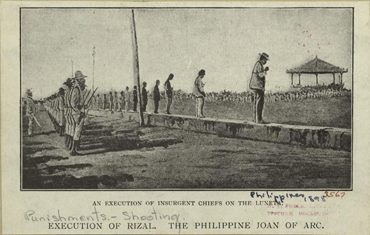
Execution of insurgents during the Philippine Revolution in the Bamumbayan Field in the 1890s.
(Image: Details from Plano de Manila y sus Arrables [Map of Manila and its Suburbs], 1898.
AMERICAN PERIOD
Bagumbayan Field was given a makeover by the great U.S. architect and town planner, Daniel Burnham (who also designed the town plan of Baguio). The area was enlarged to include both the Bagumbayan Field and the Paseo de la Luneta) and turned into a 58 acre park. Burnham planned to make this park the center of the American government in the Philippines with a whole series of U.S. government buildings around the edges of the park. In the end, due to the eruption of the Second World War, only three buildings were constructed:
-- the Congress (now housing the National Museum of the Philippines);
-- the Government Finance Building (now the National Museum of the Filipino People); and
-- the Agriculture building (now occupied by the Philippines Department of Tourism or D.O.T.).
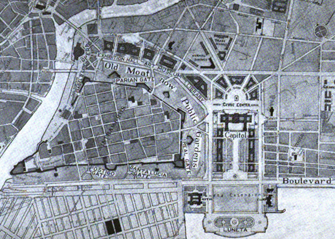
Detail from Daniel Burnham's 1912 plans for Manila showing the makeover of Luneta into a park surrounded by government buildings (Civic Center, Capitol and Luneta Extension). To the left we can see the walled city of Intramuros.
An important event during this period was the construction of the Rizal Monument in the park. This monument was built in the memory of the great Filipino patriot, writer and doctor, Jose Rizal. Its location was at the very spot where the great man had been executed by the Spanish in 1896.
The monument is inscribed with Rizal’s poem "Mi Ultimo Adios" (My Final Farewell) and Rizal’s remains area also interred at this spot.
During the American era, parts of the park were used for athletics, military parades and even rodeo shows.
In the 1940s the Grand Independence Grandstand (now known as the Quirino Grandstand after the first Philippine President ElpidioQuirino) was built on reclaimed land along Manila Bay at the western end of the park.
ERA SINCE PHILIPPINE INDEPENDENCE
On 4 July 1946 a gathering of people at the park convened for the Declaration of Philippine Independence from American rule. In the years since then the Quirino Grandstand has been the venue where each newly elected President of the Philippines has taken their oath of office and given their inaugural address.
The park fell into a state of disrepair for some years but it was revived by the successive efforts of First Lady Eva Macapagal, newspaper journalist Teodoro F. Valencia, and First Lady Imelda Marcos.
Major political rallies were held in Rizal Park by President Ferdinand Marcos and by Corazon Aquino in the lead up to the 1986 Revolution.
In 1995 Pope John Paul II addressed the assembled youth of the world gathered in Quirino Grandstand for World Youth Day.
Some recent major events that have taken place in Rizal Park include the opening ceremony of the 2005 Southeast Asian Games and missionary and evangelism events held by Christian denominations active in the Philippines such as the Iglesia ng Cristo and the El Shaddai.

The Chinese Garden in Rizal Park (Luneta)
(Photo: Wafu305.)
WHAT TO SEE IN RIZAL PARK - ITEMS ARRANGED IN ALPHABETICAL ORDER
Binhi ng Kalayaan Statue and Garden
The Binhi ng Kalayaan (Seeds of Freedom) monument is a bronze statue in memory of the unnamed Filipino patriots who fought and gave their lives in the struggle for freedom and an end to the Spanish colonial occupation of the Philippines.
The sculpture features a male and a female warrior. It was created by the Filipino sculptor Eduardo Castrillo and it was inaugurated on 12 June 1998 (the centenary date of the first declaration of Philippine independence during the Philippine Revolution). Buried underneath the sculpture is a time capsule containing documents and memorabilia relating to the Philippine Revolution.
A plaque in front of the statue reads:
"This Binhi ng Kalayaan garden is a haven of peace where one can relish the seeds of the Filipino people’s bravery, courage, and patriotism in harmony with nature.
This garden is a tribute to all the unsung Filipino heroes who gave up their lives in pursuit of human dignity, freedom and independence. Their acts of heroism shall serve as an inspiration and shall be revered by the Filipino people.
Dedicated to the future Filipino generations on the occasion of the National Parks Development Committee’s 50th anniversary on 15th January 2013."
Quirino Grandstand
Annual events held here include:
-- 12 June: Philippine Independence Day
-- 30 December: Rizal Day
-- Various religious gatherings such as the Feast of the Black Nazarene and El Shaddai's "Family Appointments"
Share this page:
Author: David Paul Wagner
(David Paul Wagner on Google+)